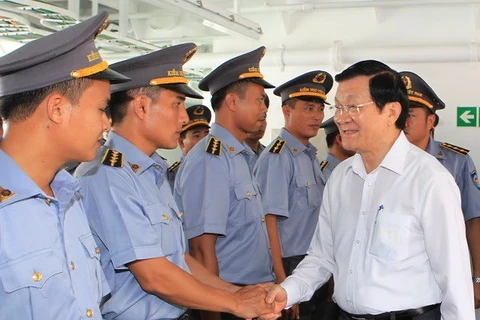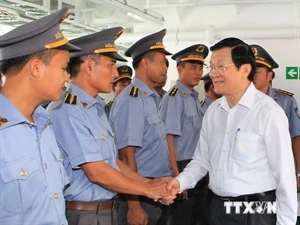Quang Ninh (VNA) – Along with economic development, urbanisation in the northern coastal province of Quang Ninh is taking place at a rapid pace.
In 1993, the province had only a second-tier urban area – Ha Long city which is considered an economic, political, cultural centre of the locality, and three towns - Cam Pha, Mong Cai and Uong Bi.
Since 2006, Quang Ninh’s strong socio-economic development, especially in industry, tourism, services and trade, has led to the formation and development of new urban areas in the locality.
The province now has 14 urban areas, including a first-tier city – Ha Long, three second-tier cities – Uong Bi, Cam Pha and Mong Cai, four fourth-tier urban areas – Quang Yen, Dong Trieu, Cai Rong and Troi towns, and six fifth-tier urban areas – Quang Ha, Tien Yen, Ba Che, Binh Lieu, Dam Ha and Co To towns.
Many apartment buildings and hotels have sprouted up across Ha Long city, along with various trade and service centres such as Ha Long I and II markets, Big C and Metro supermarkets, Vincom commercial centre, Tuan Chau international tourism centre and Vinpearl Ha Long Resort.
The new urban area and commercial centre projects have contributed to giving a facelift to the city, and driving local socio-economic development.
Quang Ninh has also invested in cultural and sport infrastructure projects in Ha Long, including the provincial museum and library, exhibition centre, 5,000-seat sporting hall and Ha Long flower park.
The Prime Minister has approved a master plan for Ha Long by 2040 with a vision towards 2050, aiming to develop the city into a world-class tourism and service hub.
The master plan targets to raise status for Ha Long city in particular and Quang Ninh province in general in the region and the world by developing the locality in a sustainable manner, meeting green growth and climate change adaptation related-requirements.
Under the master plan, Ha Long will be developed into a modern friendly sea tourism city with synchronous and modern socio-economic infrastructure systems, where the World Natural Heritage Site Ha Long Bay is preserved.
The city, which has an administrative boundary of 27,753 hectares, is expected to become a national service-tourism urban area and a driving force for regional growth.
Meanwhile, Van Don will be turned into a large-scale entertainment and resort complex, a centre of high-tech industry and an international tourism clue.
Van Don has a politically and economically important position as it lies on the strategic transit route from East Asia to Southeast Asia and from ASEAN to China, in Vietnam-China “two corridors, one belt” cooperation area, in Nanning-Singapore economic corridor and in extended Tonkin Gulf inter-regional cooperation area.
The Van Don Special Economic Zone is part of a Government-approved plan to build three such zones in the country. The other two are Van Phong in Khanh Hoa province and Phu Quoc in Kien Giang province.
Mong Cai city on the border with China will be developed into a modern international border gate, focusing on green urban development in tandem with the construction of the Hai Ha industrial park.
The Prime Minister has signed a decision to approve a master plan for building the Mong Cai border gate economic zone by 2030, a drive to make the zone a proactive and key economic growth pole in the north.
The 121,197 hectare zone will cover 17 wards of Mong Cai city, Hai Ha industrial zone and seaport, Quang Ha town and a number of communes in Hai Ha district.
It is set to include a tax-free area, industrial zones, a financial centre, an administrative centre, a residential area and other functional areas.
In addition, it will accommodate modern and comprehensive facilities with excellent service networks and diversified tourism products. Once operational, it will improve resident living standards while playing an important role in defending Vietnam’s sea and island sovereignty.
Under the development plan, the zone covers a total area of more than 120,000 hectares in Mong Cai city and Hai Ha district. It borders China in the north, and the East Sea in the south-east.
It is expected to become an important pole that drives economic progress in Vietnam's northern region and along the coast of the Gulf of Tonkin. It will also link with China's Kunming economic corridor.
Quang Ninh’s urbanisation rate has reached 75 percent, nearly doubling the national number.
The province is building a programme on urban development by 2030, aiming to develop five second-tier cities during the period.-VNA
VNA
























